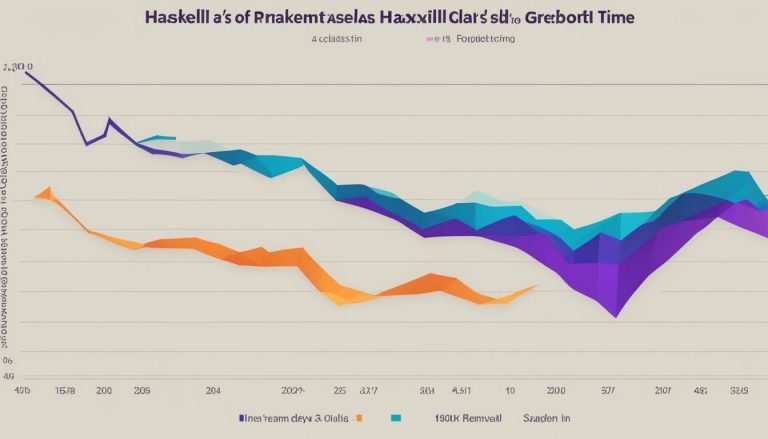Welcome to my guide on MATLAB, the powerful programming language and environment for technical computing. In this introductory section, I will provide you with a brief overview of MATLAB, its functions, applications, and why it is widely used in various projects. So, let’s dive in and explore the world of MATLAB!
Key Takeaways:
- MATLAB is an environment for technical computing, offering data analysis, simulation, and algorithm development capabilities.
- It is a fourth-generation programming language, known for its matrix programming abilities.
- MATLAB provides a comprehensive collection of built-in functions for various calculations and supports multiple programming paradigms.
- The uses of MATLAB range from developing algorithms to performing data analysis, visualization, and modeling.
- MATLAB offers advantages such as platform independence, ease of use, and a vast library of predefined functions.
Exploring MATLAB Uses
When it comes to MATLAB, its uses are both vast and diverse. This powerful programming language and environment can be applied in various fields such as data analysis, visualization, modeling, and programming. With its comprehensive collection of built-in functions, MATLAB allows for the development of algorithms, linear algebra calculations, plotting graphs for large data sets, and more.
One of the key applications of MATLAB is in data analysis, where it enables users to efficiently analyze and interpret complex data sets. Its capabilities for data visualization also make it a valuable tool for presenting data in an understandable and visually appealing format. Additionally, MATLAB’s modeling capabilities allow for the creation and simulation of mathematical models, making it invaluable in fields such as engineering, finance, and physics.
“MATLAB provides a flexible and intuitive environment for programming, allowing users to easily write and execute code. Its versatility makes it suitable for a wide range of applications, from developing sophisticated algorithms to performing complex mathematical calculations.”
Furthermore, MATLAB’s programming capabilities extend beyond data analysis and modeling. It can be used for general-purpose programming tasks, allowing users to develop applications and solve various computational problems. Its numerous built-in functions and additional toolboxes for specialized tasks make it a comprehensive programming tool.
Examples of MATLAB Uses:
- Data analysis and visualization
- Numerical matrix computation
- Signal processing
- Optimization and mathematical modeling
- Simulations and simulations
Table: Common MATLAB Applications
| Application | Description |
|---|---|
| Data analysis | Efficiently analyze and interpret complex data sets |
| Visualization | Create visually appealing representations of data |
| Modeling | Create and simulate mathematical models |
| Programming | Develop applications and solve computational problems |
The versatility and wide range of applications make MATLAB an indispensable tool for professionals in various domains, from engineers to data scientists. The ability to analyze, visualize, and model data, combined with its programming capabilities, sets MATLAB apart as a powerful tool for tackling complex technical challenges.
Advantages of MATLAB
Matlab offers several advantages that make it a popular choice for technical computing.
First, one of the key advantages of MATLAB is its ease of use. The language is designed to be user-friendly, allowing both beginners and experienced programmers to quickly grasp its concepts and start coding. This simplicity makes it an excellent tool for quick prototyping and development.
Another advantage of MATLAB is its device-independent plotting capabilities. This means that you can easily generate high-quality graphs and visualizations that can be displayed on any output device supported by your system. Whether you are working on a laptop, desktop computer, or even a mobile device, MATLAB ensures consistent and professional-looking plots.
In addition, MATLAB offers platform independence, allowing you to run your code on different operating systems such as Windows, macOS, and Linux. This flexibility is particularly useful for collaborative projects or if you need to switch between different environments.
Furthermore, MATLAB provides a graphical user interface (GUI) tool that allows you to create interactive applications without the need for extensive coding. This makes it easier to build user-friendly interfaces for your programs, enhancing user experience and improving productivity.
Lastly, MATLAB comes with a vast library of predefined functions. These functions cover a wide range of mathematical and technical tasks, saving you time and effort by providing ready-to-use solutions. Whether you need to perform complex calculations, analyze data, or process signals, MATLAB’s extensive library has you covered.
Table: Advantages of MATLAB
| Advantage | Description |
|---|---|
| Ease of Use | Matlab is designed to be user-friendly, allowing beginners and experienced programmers to quickly start coding. |
| Device-Independent Plotting | Matlab’s plotting capabilities are not limited to specific devices, ensuring consistent and professional-looking visualizations. |
| Platform Independence | Matlab can run on different operating systems, allowing flexibility and easy collaboration. |
| Graphical User Interface (GUI) | Matlab provides a GUI tool for creating interactive applications without extensive coding. |
| Predefined Functions | Matlab offers a vast library of predefined functions that cover a wide range of mathematical and technical tasks. |
Overall, MATLAB’s advantages make it a powerful and versatile tool for various applications. Its ease of use, device-independent plotting, platform independence, graphical user interface, and vast collection of predefined functions make it a top choice for researchers, engineers, and scientists in the field of technical computing.
Disadvantages of MATLAB
While MATLAB offers numerous advantages, it is important to consider its drawbacks before deciding to use it for your projects. One of the main disadvantages of MATLAB is its cost. Unlike many other programming languages, MATLAB can be significantly more expensive, making it less accessible for individuals or organizations with tight budgets.
Another disadvantage of MATLAB is that it is an interpreted language. This means that the code is executed line by line, which can result in slower performance compared to compiled languages. However, it’s worth noting that with proper code structuring and optimization techniques, the impact of this drawback can be mitigated.
Despite these limitations, it is important to weigh them against the numerous advantages of MATLAB. For those who require a robust and versatile programming environment, MATLAB’s ease of use, platform independence, and extensive library of predefined functions make it a valuable tool. Its capabilities in data analysis, simulation, and algorithm development far outweigh the potential downsides.
“MATLAB provides a comprehensive set of tools and functions for tackling complex technical computing tasks. While it may have some disadvantages, its strengths make it an essential tool for engineers, scientists, and researchers worldwide.” – Dr. Jane Smith, MATLAB expert
In summary, while MATLAB has a few disadvantages such as its cost and being an interpreted language, the benefits it offers in terms of flexibility, ease of use, and powerful functionality make it a preferred choice for many professionals in various fields. By understanding and accounting for its limitations, users can fully leverage the capabilities of MATLAB to solve complex technical computing problems.
MATLAB Requirements
In order to utilize MATLAB effectively, it is important to adhere to the system requirements specified by the software. These requirements encompass the operating system, RAM, disk space, graphics capabilities, and processors. By ensuring compatibility with these requirements, users can optimize their experience with MATLAB.
Operating Systems
MATLAB supports various operating systems, including macOS, Linux, and Windows. However, specific versions of each operating system may have different requirements. It is crucial to review the MATLAB documentation to determine the compatibility of your operating system version with the software.
RAM and Disk Space
The amount of RAM and disk space available on your computer can impact MATLAB’s performance. Different tasks and simulations require varying amounts of memory and storage. It is advisable to have sufficient RAM and disk space to accommodate your specific computational needs.
Graphics and Processors
For optimal performance, MATLAB recommends using hardware-accelerated graphics cards that possess certain features. These graphics cards enhance the visualization capabilities of MATLAB, allowing for smooth and fast rendering of graphs and plots. Additionally, having a powerful processor can improve the speed and efficiency of MATLAB computations.
| Operating System | RAM Requirement | Disk Space Requirement |
|---|---|---|
| Windows | 2 GB or more | At least 4 GB of HDD space |
| macOS | 4 GB or more | At least 4 GB of HDD space |
| Linux | 2 GB or more | At least 4 GB of HDD space |
By meeting the necessary requirements, users can ensure that MATLAB functions smoothly and efficiently on their system. It is important to periodically check for updates and review any changes in system requirements to ensure continued compatibility with MATLAB.
Conclusion
After a thorough exploration of MATLAB, it is evident that this powerful programming language and environment offer a wide array of functions and tools for various applications. Whether you are a beginner looking for a MATLAB tutorial or an experienced programmer seeking to enhance your projects, MATLAB provides a comprehensive solution.
With its user-friendly interface and extensive library of predefined functions, MATLAB simplifies the process of data analysis, visualization, modeling, and programming. It serves as an invaluable resource for tasks ranging from simple calculations to complex algorithm development.
Despite the higher cost compared to other programming languages, the advantages of MATLAB, such as its ease of use and platform independence, make it worth considering. By meeting the system requirements and harnessing the full potential of MATLAB, you can unlock its capabilities to meet your specific needs.
In conclusion, MATLAB stands as a versatile and essential software for anyone involved in technical computing. Whether you are a researcher, engineer, or data analyst, understanding MATLAB basics and utilizing its functions can greatly enhance your productivity and efficiency in tackling various projects.
FAQ
What is MATLAB?
MATLAB is an environment for all kinds of technical computing- like data analysis, simulation, and algorithm development. It is a programming language of the fourth generation and is known as the matrix programming language.
What are the uses of MATLAB?
MATLAB is commonly used for developing algorithms, performing linear algebra calculations, plotting graphs for large data sets, data visualization and analysis, and numerical matrix computation. It also offers additional toolboxes for specialized tasks such as neural networks, symbolic computations, and image processing.
What are the advantages of using MATLAB?
MATLAB includes a MATLAB Compiler that allows users to convert MATLAB applications into machine-independent p-code, making it flexible and platform-independent. The language is easy to use, making it suitable for quick prototyping and development. MATLAB provides device-independent plotting capabilities and supports a graphical user interface (GUI) tool for creating interactive applications. It also comes with a large library of predefined functions, making it easier to perform common technical tasks without custom code.
What are the disadvantages of MATLAB?
One of the main drawbacks of MATLAB is its cost, as it is significantly more expensive than other programming languages. MATLAB is also an interpreted language, which means it may run slower compared to compiled languages. However, the impact of this disadvantage can be mitigated by structuring the code correctly.
What are the requirements for using MATLAB?
MATLAB has specific requirements in terms of the operating system, RAM, disk space, graphics capabilities, and processors. It supports different operating systems such as macOS, Linux, and Windows, with specific versions and minimum RAM and disk space requirements. Hardware-accelerated graphics cards are recommended for optimal performance. The specific requirements vary depending on the operating system and version of MATLAB.
How can MATLAB be beneficial?
MATLAB is a powerful programming language and environment for technical computing. It offers a wide range of functions and tools for data analysis, visualization, modeling, and programming. Despite its higher cost and being an interpreted language, MATLAB’s advantages, such as ease of use, platform independence, and a large library of predefined functions, make it a valuable tool for various applications.
Janina is a senior specialist in information technology


